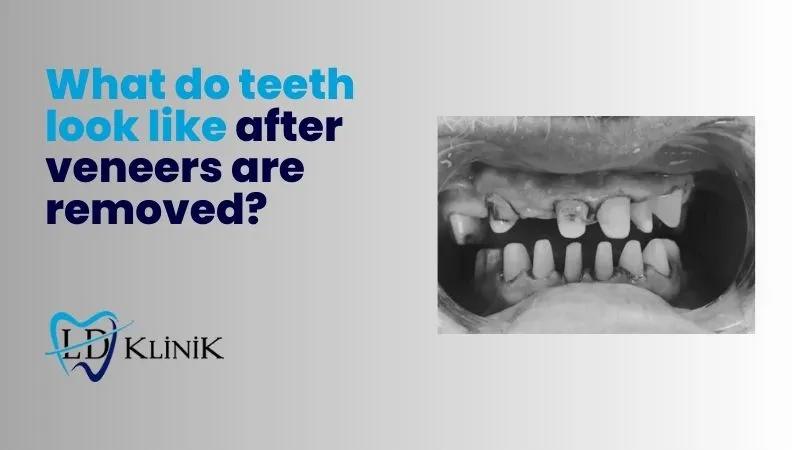A Comprehensive Solution for Tooth Replacement
If you are thinking about removing your veneers, you may wonder how your teeth will look afterwards. During the preparation process for veneers, some of the tooth enamel is shaved to help veneers adhere properly and prevent the teeth from looking too large. For these reasons, the natural teeth look smaller and rougher after veneers are removed. In addition, the dentin layer of some teeth is more yellow, so the teeth appear more yellow after veneers are removed. Teeth do not return to their original appearance. If you want to learn the answers to questions such as why veneers are replaced, how to remove them, and how to care for them, continue reading.

Veneers are replaced when they lose their function or do not meet aesthetic expectations. Veneers that have been used for many years may develop cracks, fractures, discolouration at the edges, or gum recession, or the natural tooth under the veneer may decay over time.
Daily chewing forces, teeth grinding (bruxism) and biting hard objects wear veneers over time. This leads to surface cracks or loss of gloss. When the veneer surface is damaged, the appearance it creates requires replacement due to aesthetic concerns.
Veneers are stain resistant but not completely insensitive to discolouration. Over the years, the colour of veneers becomes more yellow or stained. veneers applied today are produced in a more resistant way against factors such as discolouration, cracking and fracture.
The likelihood of gum disease increases with advancing age. Due to advanced gum recession, the roots of the teeth begin to be exposed, and the edges of veneers become visible. This causes a dark line to form and bacteria to accumulate here. Gum recession affects not only the appearance of veneers but also the health of the natural tooth underneath.
Treatment is required if the teeth under veneer have decay, fractures or old fillings. In such cases, the veneer needs to be removed and the tooth restored. Once the problem is solved, the tooth is completed with a new veneer, crown or other restoration.
The treatment after removal of the veneer depends on the state of soundness of the natural tooth. The options are as follows:
If the patient's natural teeth are healthy and veneers are old, they can choose a new veneer. These veneers are usually preferred for durability and natural appearance. Porcelain veneers last longer and are more resistant to staining than composite veneers.
Composite bonding is an alternative for patients who do not want to receive veneer treatment again after veneers are removed. It is applied to correct the shape of the teeth and cover defects. The material is shaped and polished directly on the tooth surface. The treatment time is very short. Although it is not as long-lasting as veneers, it is cheaper and easier to repair. You need to renew it every five years.
If the crown treatment is damaged not only on the front face of the tooth but also on the other surfaces, these are repaired. The dentist then places a crown on it to protect the natural tooth. Crowns, like veneers, are very robust and long-lasting. Zirconia crowns and e.max crowns in Antalya are especially durable and also provide good aesthetics.
This is one of the most frequently asked questions. Teeth cannot return to their natural state because some enamel has been removed to place veneers. Even though the teeth retain their functionality, they are unprotected because the protective enamel layer has been removed. Once veneers are removed, sensitivity and caries become more difficult to manage. In addition, it does not create a pleasant aesthetic appearance. For this reason, you need to restore your teeth with new veneers or bonding to protect the teeth and provide a better appearance.
Dental veneers are carefully removed with the dentist's special instruments. During the procedure, the dentist cuts and gently lifts the veneer, removing it without damaging the natural tooth. In some cases, veneers may break or crack during removal; this is normal and does not damage the tooth. The removal of veneers is usually done in one session, and the patient does not feel pain or soreness. You can receive your new treatment immediately after veneers are removed. You do not need to allocate a separate time for this.
There is no need for healing after the removal of veneers. After the removal of the veneer, the exposed natural tooth is not cared for to heal. It is treated directly and the front surface is covered.
After veneers are removed, patients cannot leave the clinic directly with their natural teeth. In other words, they leave with a new treatment. Regardless of which treatment they receive, the oral care routine and points to be considered are the same.
They should brush their teeth twice a day with a soft toothbrush, use fluoride toothpaste, and clean gently with dental floss. Avoiding acidic drinks, hard foods, and smoking helps protect crowns and bonding. Regular dental check-ups are also necessary to monitor the condition of the teeth.
The cost of veneer removal depends on the number of veneers to be removed and the location of the clinic. On average, there is a separate fee for removal only; additional costs are incurred if new veneers, crowns, or bonding are to be applied. Clinics usually charge a nominal veneer removal fee for patients who will receive new veneers.
Removing veneers does not cause any damage to the teeth. It is normal for the underlying tooth to look a little smaller or rough due to the preparation before the veneer, but the removal is safe.